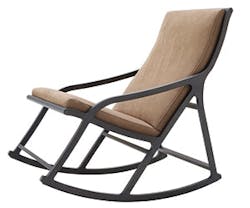The Legacy Lives on for Design Icon Pierre Paulin
When French furniture and interior designer Pierre Paulin first contacted manufacturer Ligne Roset in 2007 to discuss a collaborative partnership, it was both a landmark meeting and a bit unexpected.
Paulin, whose work is still displayed in museums such as the MoMA in New York, the Pompidou Centre in Paris, and the Tokyo Museum of Modern Art, was well-respected and internationally renowned after decades of work for brands like Thonet and Artifort before officially retiring in 1994. Over the course of his career, Paulin handled a number of high-end commissions, including decorating French president Georges Pompidou’s private apartments, furnishing the office of President François Mitterrand, and taking part in renovations of the Denon Wing of the Louvre.
On the other side was Ligne Roset, a fourth-generation, family-run company that had built a reputation by seeking out and working with young designers like Philippine Lemaire and Arthur Hoffner. That made the prospect of a partnership with Paulin an intriguing chance for the company to explore design’s past, while still retaining its place in the future.
“We were very proud that [Paulin] came to us,” said Antoine Roset, executive vice president of Ligne Roset USA. “Although we were used to working with young designers, rather than a famous one, we decided that it was a great opportunity.”
The company’s creative director, Michel Roset, soon met with Paulin and his wife, Maia, at their home in France’s beautiful Cévennes mountain range; from there, a working relationship was established quickly. The company agreed to reintroduce more than a dozen of his most iconic pieces—softly curved pieces defined by foam seats and stretch-fabric covers—starting with the re-launch of his Pumpkin Chair in 2008.
“From Pierre Paulin’s first visit to our upholstery factories, we knew that the Pumpkin model was best suited to the know-how and philosophy of Ligne Roset,” said Michel. “From that point, everything worked out perfectly.”
Because the pieces are reissues, noted Michel, the design process required only that Paulin approve the overall direction of the product, “particularly with regard to the introduction of new materials, since these products were often coming to the market 30 years or more after their original conception. By listening to him, we tried to improve the models based on his comments. Pierre Paulin was a remarkable man of his time, for his eclecticism and his interest in all the new processes and innovations.”
Paulin’s chance to see his designs re-imagined with new materials was unfortunately short-lived, as he passed away in June of 2009. Since then, Maia has remained an integral part of the collaborative process, working closely with Michel to bring Paulin’s colorful creations to a new generation of buyers. The Paulins’ son, Benjamin, has also joined the partnership; he plays a role in overseeing manufacturing, distribution, and the introduction of new products.
Today, Ligne Roset offers 14 pieces by Paulin, including three new items: Gavrinis 2, a 100 percent wool, hand-tufted, sculpted rug based on Paulin’s sketches of carvings adorning an ancient tomb he saw during a visit to the island of Gavrinis; Elysee, a re-creation of the 1971 Élysée Palace collection designed for President Pompidou; and Derive 2, a reinterpretation of a rocking armchair that Paulin made for President Pompidou’s wife, Claude. Several new pieces are also in progress, including new upholstery and cabinet products from Paulin’s archives; the company plans to unveil them at design shows in Paris and Cologne in 2015.
While all of the pieces are contemporary in look and feel, Ligne Roset is careful to stay true to Paulin’s original drawings, proportions, and aesthetics. “Regarding furniture, nothing changes except lacquers or tints,” said Michel. “For upholstery, the updating process is mainly due to the improvement of filling materials and the quality of new fabrics and leathers. The manufacturing know-how also improves over time.” Molded plastics and upgraded foam provide the reissued pieces with the durability and comfort modern contract spaces demand, while still retaining Paulin’s distinctive and inventive aesthetic.
“When you look at the work of Pierre Paulin 40 or 50 years ago, I think very few people understood what he was doing,” said Antoine. “But years later, people see how great the design was. It’s like fashion and art—it comes back. The trends of the 1970s are very stylish today, and naturally, people realize that the designs done in this time were already great.
“When you look at the Pumpkin, or the Elysee collection at the Élysée Palace in France, President Pompidou and his wife were very modern,” he added. “It was very new at that time and difficult for many people to understand, but today it looks contemporary.”
